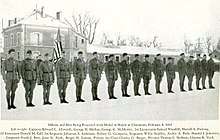Johannes S. Anderson
| Johannes S. Anderson | |
|---|---|
 Medal of Honor recipient | |
| Born |
July 20, 1887 Grand Duchy of Finland, |
| Died | April 15, 1950 (aged 62) |
| Place of burial | Acacia Park Cemetery and Mausoleum Chicago, Illinois |
| Allegiance |
|
| Service/ |
|
| Years of service | June 19, 1916 to May 30, 1919 |
| Rank |
|
| Unit |
|
| Battles/wars | World War I |
| Awards |
|
Johannes Seigfried Anderson[1] (July 20, 1887 – April 15, 1950) was a Finland born U.S. Army soldier during World War I, and a Medal of Honor recipient.
Biography
Little is known of Anderson's early life, other than that he was born in Finland July 20, 1887, and entered the US Army in Chicago, Illinois June 19, 1916. On October 8, 1918, while fighting near Consenvoye, France, while his unit was pinned down by heavy German machine gun fire, First Sergeant Anderson volunteered to leave his unit in an attempt at flanking the enemy machine gun emplacement. He made his advance under heavy fire, over open ground, reaching the emplacement and killing the machine gun crew. He silenced the machine gun, captured it, and returned with twenty three German prisoners of war.
He died April 15, 1950 and is buried in Acacia Park Cemetery and Mausoleum Chicago, Illinois.[2] His grave can be found in Poplar Section, Lot NE 25, Block 1, Grave 2.[2]
Medal of Honor Citation

- Rank and organization: First Sergeant, U.S. Army, Company B, 132d Infantry, 33d Division.
- Place and date: At Consenvoye, France, October 8, 1918.
- Entered service at: Chicago, Ill., June 19, 1916
- Birth: Finland.
- General Orders No.16, War Department, 1919.
Citation:
While his company was being held up by intense artillery and machinegun fire, 1st Sgt. Anderson, without aid, voluntarily left the company and worked his way to the rear of the nest that was offering the most stubborn resistance. His advance was made through an open area and under constant hostile fire, but the mission was successfully accomplished, and he not only silenced the gun and captured it, but also brought back with him 23 prisoners.
See also
Notes
- ↑ Hall of Valor
- 1 2 "Johannes S. Anderson". Claim to Fame: Medal of Honor recipients. Find a Grave. Retrieved 2008-01-30.
References
- "Johannes S. Anderson". Claim to Fame: Medal of Honor recipients. Find a Grave. Retrieved 2008-01-30.
- "Johannes S. Anderson Medal of Honor citation". Retrieved September 29, 2010.